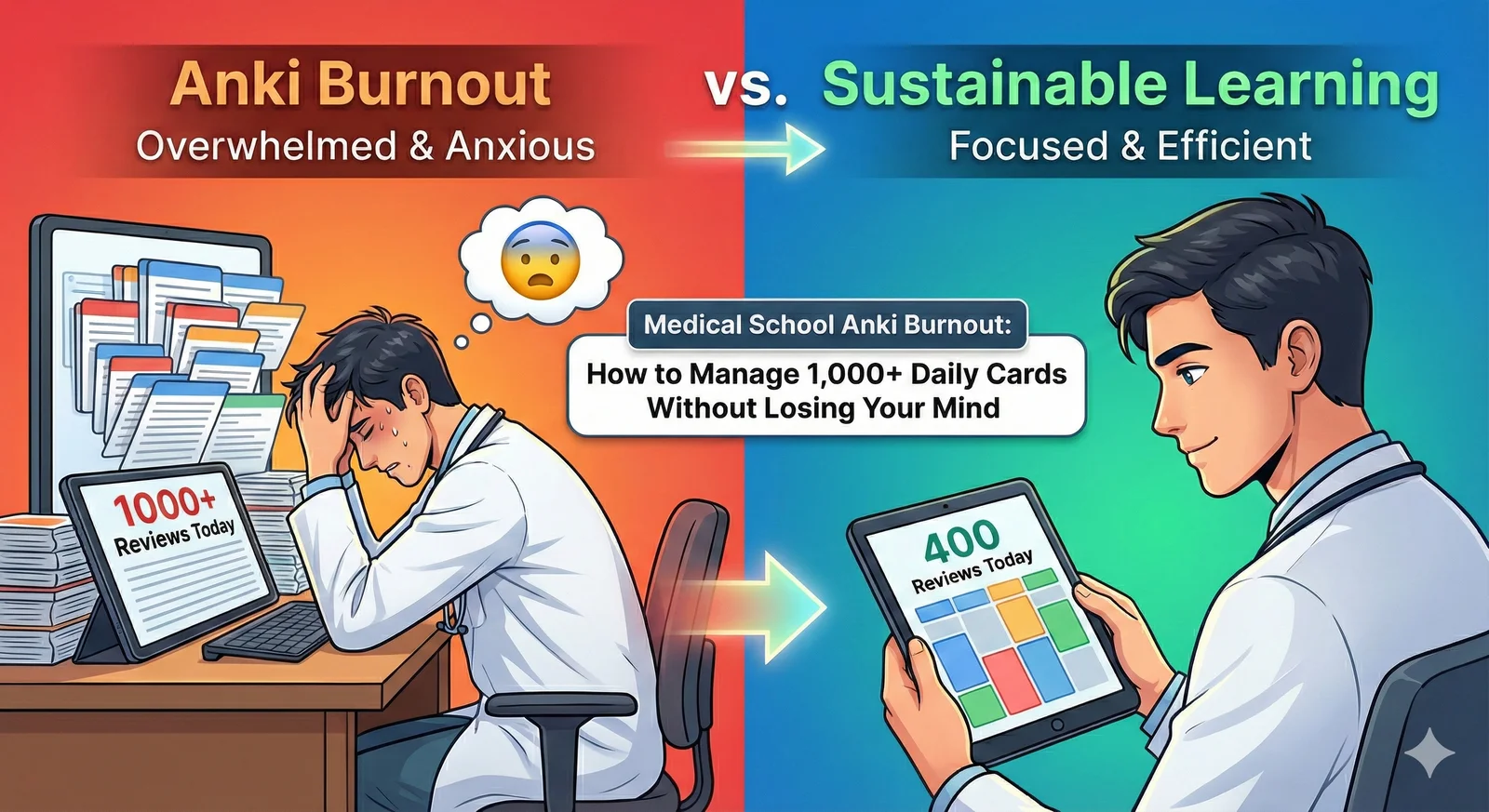
Medical School Anki Burnout: How to Manage 1,000+ Daily Cards Without Losing Your Mind
Practical strategies for medical students drowning in Anki reviews. Emergency triage for backlogs, sustainable daily limits, and how to eliminate the card creation bottleneck.
TL;DR
Practical strategies for medical students drowning in Anki reviews. Emergency triage for backlogs, sustainable daily limits, and how to eliminate the card creation bottleneck.
Table of Contents
Need help turning messy notes into clean flashcards?
MemoForge pulls highlights, structures prompts, and exports straight to Anki so your study time stays focused on recall.
Medical School Anki Burnout: How to Manage 1,000+ Daily Cards Without Losing Your Mind
You open Anki and see 1,247 cards due. Your stomach drops. You've already studied for five hours today. You haven't eaten a real meal. You've cancelled plans with friends for the third week in a row. And somehow, the number keeps growing.
This is medical school Anki burnout. It's real, it's common, and it's not your fault.
Here's how to fix it—both the immediate crisis and the underlying system.
The Medical School Anki Crisis
Let's quantify this because numbers help:
- 800-1,000+: Average daily reviews reported by preclinical students using AnKing
- 4-6 hours: Daily Anki time for many students
- 27,000+: Cards in the full AnKing deck
- 72.7%: Medical students not getting enough sleep
- 68%: Seniors reporting extreme stress (Class of 2025)
And here's the kicker: the Class of 2025 faces the toughest job market in a decade, with only 30% securing full-time positions before graduation. The anxiety compounds.
This isn't weakness. This is math. The system is demanding more than humans can sustainably deliver.
Why It's Worse Now
Several factors have intensified the Anki burden:
Preclinical condensation. Many schools compressed preclinical from 2 years to 18 months. Same content, less time.
Comprehensive decks. AnKing v12 is 27,000+ cards. Older decks were 10,000. More coverage means more maintenance.
Step 1 pass/fail. Students now hedge their bets, studying both for Step 1 and for shelf exams. Double the material.
Comparison culture. r/medicalschoolanki posts celebrate "I do 800 reviews daily." Everyone thinks they need to match it.
Fear of falling behind. Missing one day creates a backlog. Missing a week creates dread. The guilt spiral begins.
The Psychological Toll
Beyond time, Anki burnout hits mental health hard:
- Guilt over missed reviews: That red number haunts you
- Comparison anxiety: Others seem to handle it fine
- FOMO about deck completeness: What if you suspend the wrong card?
- Sleep deprivation: One more review session, then bed... at 2 AM
- Loss of identity: You become "the person who does Anki"
If you're experiencing these, you're not broken. You're responding rationally to an irrational workload.
Emergency Triage: When You Have 500+ Overdue
Let's address the immediate crisis first. If you're staring at a mountain of overdue cards:
Step 1: Stop the Bleeding
Set new cards to zero. Right now. Go to Options → New Cards/Day → 0.
This feels wrong. It's not. You're stopping new water from flowing into a sinking boat.
Step 2: Time-Budget Your Reviews
Pick a daily time cap you can actually do:
- 30 minutes: Sustainable long-term
- 60 minutes: Heavy but manageable
- 90 minutes: Crunch time only
Use a timer. When it rings, stop. Even if cards remain.
Step 3: Create a Rescue Filtered Deck
Build a filtered deck that pulls your oldest overdue cards:
is:due prop:due<-7
This grabs cards overdue by a week or more. Set it to pull 50 cards. Clear that batch daily.
This search string works on current Anki desktop and mobile builds; keep Anki updated so search syntax stays consistent.
Alternatively, just pull a flat 50-75 cards per day. The number shrinks, which feels good.
Step 4: Expect 2-3 Weeks
At 50 cards/day, a 500-card backlog takes 10 days. At 75 cards/day, about a week. This is normal. Don't sprint.
The math is your friend. Trust the rhythm.
Sustainable Long-Term Solutions
Triage handles the immediate crisis. These solutions prevent it from recurring.
Time-Budget-First Approach
Most students set card limits based on hopes, not reality.
Flip it. Start with your actual available time:
20 minutes daily:
- New cards: 5-8
- Reviews: ~100
- Result: Slow growth, zero stress
40 minutes daily:
- New cards: 12-15
- Reviews: ~180
- Result: Steady progress
60 minutes daily:
- New cards: 20-25
- Reviews: ~250
- Result: Heavy but doable
More than 60 minutes is not sustainable. If your deck requires more, you need fewer cards, not more time.
The Card Creation Bottleneck
Here's something critical: 30-40% of your "Anki time" isn't actually spaced repetition.
It's creating new cards.
If you rely on AnKing for Step 1, your bottleneck isn't creation—it's unsuspending too many cards too fast. But for in-house exams and lecture decks where AnKing doesn't cover you, creation is the killer. That's where MemoForge fits.
Think about it:
- Reading lecture slides to identify flashcard-worthy content
- Typing questions and answers
- Formatting cloze deletions
- Adding images
- Quality-checking for errors
For a 50-minute lecture, you might spend 30-60 minutes making cards before you've reviewed a single one.
This is the bottleneck that creates unsustainable loads. You're spending hours on card creation, leaving insufficient time for actual studying. Then reviews pile up.
The solution: Automate card creation so you can focus on review.
This is where tools like MemoForge help. Upload your lecture PDF, get quality-scored cards back in minutes, export to Anki. You skip the 30-60 minutes of creation and go straight to learning.
The math changes dramatically:
- Manual workflow: 60 min creation + 60 min review = 2 hours
- Automated workflow: 5 min upload + 60 min review = 65 minutes
That's an hour saved per lecture. Across a semester, that's 50+ hours—a full work week.
Smart Deck Management
Not all cards deserve equal attention.
Suspend low-yield content:
- Rare diseases you'll never see
- Obscure drug names
- Historical facts that won't be tested
It feels dangerous to suspend cards, but it's more dangerous to burn out and do zero cards.
Prioritize by exam:
- Pre-Step: Focus on high-yield Step content
- Post-Step pass/fail: Focus on shelf-specific material
- Clinical years: Focus on practical management
Use tags aggressively:
- Tag by system, by test, by yield
- Create filtered decks for specific study sessions
- Review tag statistics to identify weak areas
AnKing Customization
If you're using AnKing, you don't need the full 27,000.
Realistic coverage targets:
- For Step 1 pass: 60-70% of deck (~16,000-19,000 cards)
- For shelf exams: Specific subdeck completion
- For clinical rotations: Relevant system + high-yield
Suspension strategy:
- Start with everything suspended
- Unsuspend by system as you study
- Only unsuspend what you've actually learned
- Leave "maybe someday" cards suspended
This prevents the guilt of incomplete decks while keeping your load manageable.
The Mental Health Framework
Beyond logistics, you need psychological sustainability.
Set Boundaries
- No Anki after [time]: Sleep matters more than 50 extra cards
- One full day off weekly: Yes, you'll have a backlog Monday. It's worth it.
- Meals first: No reviews during eating. Presence matters.
Take Strategic Breaks
The guilt around missing Anki is real. Here's permission to ignore it:
- A 3-day break creates a 150-card backlog
- At 50 cards/day extra, that's 3 days to clear
- The mental reset is worth 3 days of catchup
Seriously. Take breaks.
Recognize When to Scale Back
Anki is a tool, not an identity. If it's harming more than helping:
- Reducing your deck is not failure
- Using Anki for only high-yield topics is valid
- Stopping Anki entirely is an option
Some successful physicians never used Anki. It's one method among many.
Alternative Approaches
Consider hybrid methods that reduce Anki dependency:
Selective Anki:
- Use Anki only for highest-yield 30% of content
- Use other methods (practice questions, teaching) for the rest
Topic-limited Anki:
- Use Anki for dense factual content (pharm, micro)
- Use other methods for conceptual content (physiology)
Active Anki:
- Create cards only from practice questions you miss
- This ensures cards are high-yield and tested
You don't have to Anki everything. Permission granted.
Success Case Studies
These are patterns from students who reduced load while maintaining or improving performance:
Case 1: The Trimmer
Before: 1,000 daily cards, 4 hours Anki, burning out After: 400 daily cards, 90 minutes Anki, performing better
What changed:
- Suspended lowest-yield 60% of AnKing
- Used time-budget approach (90 min max)
- Automated card creation for new lectures
- Scores improved because more time for practice questions
Case 2: The Hybrid
Before: Full AnKing, behind on reviews, anxious After: Anki only for pharm/micro, other methods for rest
What changed:
- Recognized Anki works best for dense facts
- Switched to active recall via practice questions for other systems
- Reduced daily cards from 800 to 300
- Reduced anxiety significantly
Case 3: The Automator
Before: 2 hours daily creating cards + 2 hours reviewing After: 30 minutes reviewing AI-generated cards
What changed:
- Stopped manual card creation entirely
- Used MemoForge to generate from lecture PDFs
- Only reviewed and edited AI cards
- Time saved used for practice questions and sleep
Frequently Asked Questions
How do I catch up on 2,000 overdue cards?
Don't try to do it in a week. Set new cards to zero, pull 75 overdue per day via filtered deck, expect 4 weeks to clear. Sustainable beats fast.
Should I reset my deck and start over?
Rarely. You'd lose all scheduling data. Better to suspend unwanted cards and aggressively trim. Only reset if your deck is truly beyond repair.
How do I decide what to suspend?
Ask: "Would this card help me on Step or shelf?" If no, suspend. When in doubt, keep it but tag it "maybe suspend" for later review.
What if I can't reduce below 500 daily cards?
Check your settings and card quality. High-quality atomic cards review faster. FSRS algorithm reduces reviews by 20-30%. Better cards + better algorithm = fewer reviews.
Should I feel guilty about not finishing AnKing?
No. AnKing is comprehensive, not mandatory. Many students pass Step with 60% completion. Completion rate doesn't correlate with scores nearly as much as practice questions do.
When should I take a complete Anki break?
When it's affecting your health, relationships, or overall study effectiveness. A week off won't destroy your knowledge. It might save your mental health.
A Path Forward
Anki burnout is a systems problem with systems solutions.
Immediate:
- Stop new cards
- Time-cap reviews
- Triage via filtered deck
Medium-term:
- Set sustainable limits via time-budget approach
- Automate card creation
- Trim to high-yield content
Long-term:
- Reconsider Anki's role in your learning
- Protect mental health as a priority
- Remember: You're training to help people, which requires you to be a functional person
The tools exist. MemoForge eliminates card creation time. FSRS reduces review load. Proper settings prevent backlogs. The question is whether you'll implement them.
You don't have to grind 6 hours daily. You don't have to sacrifice your wellbeing. You can be a successful medical student with sustainable Anki practices.
Start with one change today.
Ready to eliminate the card creation bottleneck? MemoForge generates quality flashcards from your lecture PDFs in minutes—so you can spend your time actually learning. Try it free and take back your schedule.
Related Articles

FSRS vs SM-2: The Complete Guide to Anki's New Algorithm for Medical Students
Everything you need to know about switching from SM-2 to FSRS in Anki. Step-by-step migration guide, optimal settings for medical school, and real data showing 20-30% fewer daily reviews.

Anki Backlog Rescue: Settings, Habits, and Filters to Clear Reviews Fast
Pause new cards, set time-based review caps, use parent deck limits, and build rescue filtered decks to eliminate your Anki backlog without burnout.

Anki Daily Load Settings: Optimal New Card Limits, Ease Factors, and Leech Fixes
Follow 20, 40, and 60 minute Anki study presets with recommended new card caps, review limits, ease tweaks, and leech actions to prevent overload.